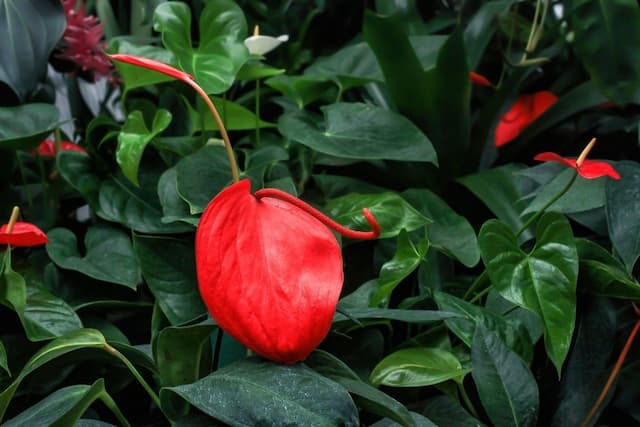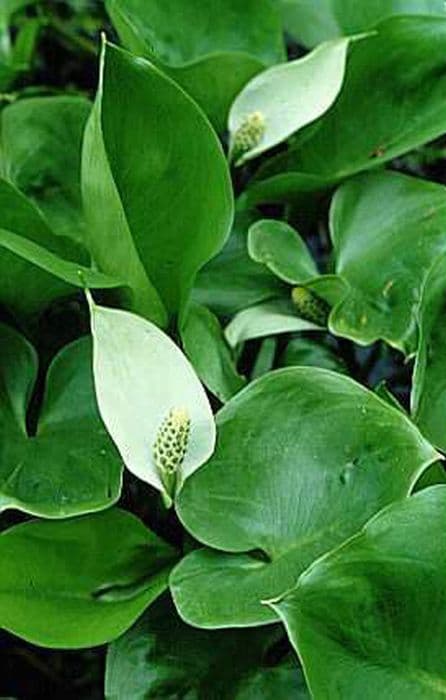Calla Lily 'Gsccnabo' Zantedeschia Natural Bouquet = 'Gsccnabo' (PBR)
![arum lily [Natural Bouquet]](/_next/image?url=https%3A%2F%2Fplants-admin.emdemapps.com%2Fimages%2Fplants%2F%2Fimages%2F604b63358300f.png&w=3840&q=75)
ABOUT
The Zantedeschia Natural Bouquet, more commonly known as Calla Lily, bears an elegant and distinctive look. The plant showcases trumpet-shaped flowers that exhibit a creamy white hue with hints of green, which give off a pure and sophisticated vibe. The flowers are characterized by a smooth texture and a rolled edge that spirals to a point, resembling a funnel. Surrounding the central spadix, which holds the flower's reproductive organs, the spathe gracefully unfurls, forming the iconic shape that has made Calla Lily a favorite in floral arrangements and gardens alike. The foliage of the Calla Lily provides a lush backdrop to the flowers, with large, arrow-shaped leaves that are a glossy deep green. The leaves may sometimes display spotted or speckled patterns, adding further visual interest to the plant. The combination of its striking flowers and vibrant green leaves makes the Calla Lily a captivating plant, providing an air of sophistication to its surroundings whether displayed indoors in pots or cultivated in outdoor flowerbeds. Its appearance has cemented its status as a symbol of beauty and elegance in the plant world.
About this plant
 Names
NamesFamily
Araceae
Synonyms
Calla Lily, Arum Lily
Common names
Zantedeschia Natural Bouquet = 'Gsccnabo' (PBR)
 Toxicity
ToxicityTo humans
The Calla Lily contains compounds that are toxic to humans if ingested. Symptoms of poisoning can include irritation of the mouth and throat, nausea, vomiting, and diarrhea. Ingesting any part of the plant can lead to significant discomfort and health issues, primarily because of the oxalate crystals it contains, which can cause swelling and a burning sensation.
To pets
The Calla Lily is toxic to pets as well, including dogs and cats. Symptoms of poisoning in pets are similar to those in humans, such as drooling, vomiting, difficulty swallowing, and irritation of the mouth. The calcium oxalate crystals in the plant can cause severe symptoms and potentially lead to serious consequences if not addressed promptly.
 Characteristics
CharacteristicsLife cycle
Perennials
Foliage type
Evergreen
Color of leaves
Green
Flower color
Varies
Height
1-2 feet (30-60 cm)
Spread
1-2 feet (30-60 cm)
Plant type
Herb
Hardiness zones
8
Native area
Africa
Benefits
 General Benefits
General Benefits- Easy to Grow: The plant is known for being easy to cultivate in a variety of climate conditions.
- Long Blooming Period: It can produce flowers for an extended period, often throughout the spring and summer months.
- Versatile Usage: Suitable for planting in beds, borders, and containers, offering flexibility in garden design and landscaping.
- Attractive Flowers: Zantedeschia Natural Bouquet produces beautiful flowers that can be used as cut flowers for arrangements and bouquets.
- Drought Tolerant: Once established, it has good drought resistance, reducing the need for frequent watering.
- Low Maintenance: It requires minimal care once established, making it ideal for gardeners of all skill levels.
 Medical Properties
Medical PropertiesThis plant is not used for medical purposes.
 Air-purifying Qualities
Air-purifying QualitiesThis plant is not specifically known for air purifying qualities.
 Other Uses
Other Uses- Photography Prop: The calla lily's elegant shape and colors make it a popular choice for photographers looking for a natural element in portrait and still-life photography.
- Art Inspiration: With its distinctive form and variety of colors, artists often use calla lilies as a subject for paintings, drawings, and sculptures.
- Fine Dining Decoration: Because of its sophisticated appearance, calla lilies are used to enhance the ambiance at high-end restaurants, gracing tables and reception areas.
- Eco-Friendly Funerals: Calla lilies are chosen for green burials due to their biodegradable nature and symbolism of purity and resurrection.
- Handcrafted Jewelry: The blooms and shape of the calla lily serve as an inspiration for jewelers to create nature-inspired earrings, pendants, and other accessories.
- Water Garden Feature: Calla lilies can be grown in containers submerged in water gardens due to their marshland origin, adding an exotic touch.
- Fashion Design: Calla lilies have influenced fashion designers in creating floral prints and motifs that mimic the flower's graceful curves.
- Ceramic and Glass Work: These flowers are often depicted in ornate designs on vases, plates, and other decorative items in ceramics and glassware.
- Educational Tool: Calla lilies can be used in botanical studies and floristry courses to teach plant anatomy and flower arranging techniques.
- Home Deodorizer: When placed in a water bowl, calla lilies can lightly scent a room with their subtle fragrance.
Interesting Facts
 Feng Shui
Feng ShuiThe Calla Lily is not used in Feng Shui practice.
 Zodiac Sign Compitability
Zodiac Sign CompitabilityThe Calla Lily is not used in astrology practice.
 Plant Symbolism
Plant Symbolism- Purity and Innocence: Calla lilies, the common name for Zantedeschia, are often associated with purity and innocence due to their sleek, white blossoms.
- Virginity: Their white color has also made them symbolic of virginity in various cultures and ceremonial practices.
- Beauty: The elegant form and attractive appearance of calla lilies stand for beauty and sophistication.
- Resurrection: In Christian symbolism, the calla lily has been associated with Jesus' resurrection due to its trumpet-like shape suggesting triumph.
- Rebirth: Their perennial nature makes them a symbol of life cycles, rebirth, and new beginnings.
- Marriage and Devotion: Because they bloom in spring and early summer, they are often used in weddings to signify marital bliss, devotion, and true commitment.
- Transcendent Love: The flower's ability to emerge with grace above the water in its natural habitat is symbolic of love's ability to rise above life's challenges.
 Water
WaterCalla lilies, like the Zantedeschia Natural Bouquet, prefer to be kept moist but not soggy. Water the plant thoroughly when the top inch of soil feels dry to the touch, approximately once a week, depending on environmental conditions. Add enough water so that it begins to drain from the bottom; this might be around half a gallon for a medium-sized pot. During the growing season in spring and summer, they may require more frequent watering, closer to twice a week, but always check the soil moisture level first. In the dormant winter period, reduce watering to every other week or less.
 Light
LightCalla lilies thrive in bright, indirect sunlight. An ideal spot would be a location that receives several hours of morning sunlight but is shaded during the harshest, hottest part of the afternoon sun. If grown indoors, place the plant near a sunny window where it can get plenty of light without being exposed to too much direct sunlight that can scorch the leaves.
 Temperature
TemperatureCalla lilies prefer temperatures in the range of 60 to 75 degrees Fahrenheit. They can survive temperatures as low as 50 degrees Fahrenheit, but growth will be reduced. Temperatures above 75 degrees Fahrenheit can promote dormancy in the plant. To encourage flowering and healthy growth, maintaining consistent temperatures within this ideal range is best.
 Pruning
PruningPrune calla lilies to remove dead or yellowing leaves and spent flowers to encourage new growth and maintain the plant's appearance. This light pruning can be done any time of the year as needed. The best time for more thorough pruning is after the flowers have faded, typically in late summer or early fall, to prepare the plant for dormancy.
 Cleaning
CleaningAs needed
 Soil
SoilFor the Calla Lily (Zantedeschia Natural Bouquet), the best soil mix is well-draining, rich in organic matter with a pH of 6.0 to 6.5. A mix of peat, perlite, and compost would be suitable.
 Repotting
RepottingCalla Lilies should be repotted every 1 to 2 years to refresh the soil and accommodate root growth.
 Humidity & Misting
Humidity & MistingCalla Lilies thrive in higher humidity levels, preferring a range of 50-60% for optimal growth.
 Suitable locations
Suitable locationsIndoor
Place in bright, indirect light with high humidity.
Outdoor
Plant in partial shade, sheltered from strong winds.
Hardiness zone
8-10 USDA
 Life cycle
Life cycleThe Calla Lily 'Natural Bouquet', scientifically known as Zantedeschia Natural Bouquet = 'Gsccnabo' (PBR), begins its life as a rhizome, a bulb-like underground stem that stores nutrients. Upon germination, it sprouts and develops into a rosette of arrow-shaped leaves. The plant then produces a stalk, or spadix, surrounded by a colorful spathe, which is often mistaken for a flower. Following pollination, which usually involves attracting insects with its striking spathe, the spadix produces small berries containing seeds. If conditions allow, these seeds can disperse and germinate, creating new plants. Once the growing season concludes, the plant enters a period of dormancy where the above-ground foliage dies back, and the rhizome survives underground until favorable conditions return for the next growing cycle.
 Propogation
PropogationPropogation time
Spring to Summer
The plant commonly known as Calla Lily, specifically the Zantedeschia Natural Bouquet 'Gsccnabo' (PBR), is often propagated by division, which is a process that typically takes place in spring or autumn. To propagate by division, the rhizomes of the plant are carefully dug up and then separated into smaller sections, each with at least one growth point. These divisions can be replanted immediately and are generally placed about 4 inches (approximately 10 centimeters) deep in well-draining soil. They should be spaced about 12 inches (roughly 30 centimeters) apart to allow adequate room for growth. The new plants will usually bloom within the first or second growing season after division. Care should be taken not to damage the rhizomes during the division process to ensure successful propagation.









